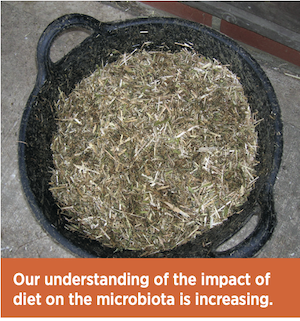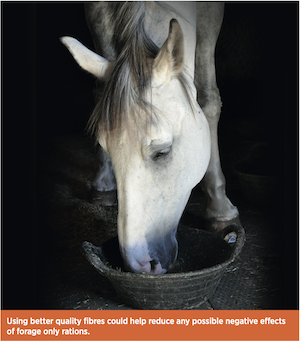
FIBRE FOR THE PERFORMANCE HORSE
By Katie Williams M.Sc. (Dist) R Nutr, technical and product development manager at Dengie
AMTRA is required by the Veterinary Medicines Regulations to ensure its RAMAs/SQPs undertake CPD. All RAMAs/SQPs must earn a certain number of CPD points in a given period of time in order to retain their qualification. RAMAs/SQPs who read this feature and submit correct answers to the questions below will receive two CPD points. For more about AMTRA and becoming a RAMA/SQP, visit www.amtra.org.uk
The importance of supplying sufficient fibre for all horses is widely appreciated and 1.5% of bodyweight on a dry matter basis is increasingly accepted as the minimum amount of forage required to maintain digestive health and function.
However, the perceived need for cereals and the energy they supply persists despite their links to diseases and behavioural issues.
The use of high levels of cereals is widely accepted to increase the risk of diseases such as ulcers and colic, not only because of the high levels of starch the cereals contain but also the concomitant decrease in forage intake that usually results.

The high prevalence of ulcers is widely cited as the rationale for exploring how fibre-based diets can contribute to the energy requirements of performance horses. This review of key studies that have been carried out to date aims to highlight how fibre can make a greater contribution to the energy requirements of performance horses than is often believed.
DOES TOO MUCH FORAGE COMPROMISE PERFORMANCE?
Reports as far back as the 1980s highlight the reduction in bodyweight that low forage intakes result in (Carroll and Huntington 1988). More recent studies (Ellis et al, 2002) showed average bodyweights were around 10kgs lower when horses were fed 50% forage rather than 100% forage diets.

At Dengie, we have weighed a range of horses who had forage withheld overnight in preparation for an exploratory gastroscope and found a reduction of around 17-20kgs in their weights which is equivalent to a typical bag of feed. This drop in weight results from waste or indigestible material passing out of the digestive system and not being replaced!
Clearly the horse has a large digestive system which can hold a lot of fibrous material but it also contains a lot of water too; around 50 litres in fact.
The amount is significantly influenced by diet as fibre acts as a fluid reservoir in the gut. Meal feeding has been shown to result in transient dehydration in the gut and feeding a few large meals each day can cause sufficient dehydration in the colon to result in impaction which could initiate other forms of very serious colic such as large colon displacement and volvulus (Blikslager and Mair, 2021).
So, whilst withholding forage helps to reduce gut fill and therefore the weight the horse has to move around when racing or competing, there are potential consequences. The dehydration from meal feeding AND low forage intakes may well be responsible for the increased risk of colic and muscle issues seen in performance horses.
It is also important to consider whether a difference of 10kgs is significant? Ellis et al (2002) found that maximum heart rates were higher in submaximal exercise tests for those on higher forage diets but in recovery there was little difference in heart rate between those fed 50 or 80% forage diets.
Subsequent studies such as by Jansson and Lindberg (2012) have shown that although forage only diets did result in changes to the metabolic response to exercise, there were generally positive rather than negative effects on performance. They did find that horses had lower muscle glycogen stores – which would be expected if starch intake is lower – but the utilisation of glycogen during exercise was the same.

The horses in the study were only fed haylage and the researchers suggested using even better quality fibres could help reduce any possible negative effects of forage only rations.
It is likely that we are a long way from convincing racehorse trainers to change to a total forage diet; but perhaps there is scope to convince them and those competing in other sporting disciplines that lower levels of cereals can be fed if quality sources of fibre are used.
Recent studies, which were presented at the European Workshop on Equine Nutrition in 2022, compared the performance of horses fed a combination of chopped alfalfa and oats alongside their forage with those just fed oats and forage.
They found no difference in speed, maximal power or muscle thickness between the two groups. In addition, the same research group found that when higher than recommended starch levels were fed, the addition of alfalfa helped to counteract potential negative effects on the microbiome and fermentation process. This was measured by acidity levels, bacterial functional groups and volatile fatty acid (VFA) levels in gastric and faecal samples. VFAs are the end products of fermentation and, as the name suggests, are acidic in nature.
The level of acidity of different acids produced varies with those from fibre tending to be weaker than those fermented from starch. This is why if starch spills over into the hind gut, it is fermented thereby creating a more acidic environment. It is this change that disrupts the microbial population.
IMPACT OF DIET

Our basic understanding of the impact of diet on the microbiota is increasing and again, it is well accepted that adding cereals increases the bacteria that digest starch at the expense of fibre digesting bacteria also described as fibrolytic bacteria. The horse gut microbiota consists of approximately 10⁹ microorganisms per gram of ingesta in the caecum and Mach et al (2020) suggest that physical exertion and stress may have a significant, albeit temporary effect, on the gut microbiota composition and host metabolism. The researchers also suggest that the type and intensity of physical training may impact the gut microbiota too.
The significance of this is yet to be fully understood but studies in humans are showing significant links between the microbiota and the health and behaviour of the host animal.
We are just starting to understand more about this in the context of the horse too. It is known that VFAs produced in the gut interact with the cells of the gut and activate the production of serotonin – a neurotransmitter sometimes referred to as the happy chemical. What isn’t known yet in the horse is how the different proportions of VFAs may impact on behaviour.
Previous studies have compared high fibre versus starch-based rations and found horses on high fibre rations had lower resting heart rates and were less reactive to novel stimuli (Bulmer et al, 2015). Although racehorse trainers may be less focussed on behaviour than those training and riding sports horses, there are definitely examples of horses losing races before they even get to the start line as they have become too over-excited in the paddock.
As always, there is still so much to learn; but the latest studies and research are showing that fibre should very much be a part of the performance horse’s ration if we want to maximise health without compromising performance.
References:
Blikslager, A.T and Mair, T.S. (2020) Trends in the management of horses referred for evaluation of colic: 2004–2017. Equine Veterinary Education
Bulmer et al (2015) The effects of high starch or high fibre diets on equine reactivity and handling behaviour. Applied Animal Behaviour Science.
Carroll and Huntington (1988) Body condition scoring and weight estimation of horses. EVJ. 20.
Ellis et al (2002) Effect of forage intake on bodyweight and performance. EVJ Supplement 34.
Julliand et al (2018) Effect of dehydrated alfalfa on equine gastric and faecal microbial ecosystems. Livestock Science.
Mach et al (2020) Gut microbiota is associated with equitation conditions and behaviour in horse athletes. Nature – Scientific Reports.

ABOUT ETN’S RAMA/SQP FEATURES
ETN’s series of CPD features helps RAMAs (Registered Animal Medicines Advisors/SQPs) earn the CPD (continuing professional development) points they need. The features are accredited by AMTRA, and highlight some of the most important subject areas for RAMAs/ SQPs specialising in equine and companion animal medicine.
AMTRA is required by the Veterinary Medicines Regulations to ensure its RAMAs/SQPs undertake CPD. All RAMAs/SQPs must earn a certain number of CPD points in a given period of time in order to retain their qualification. RAMAs/SQPs who read this feature and submit correct answers to the questions below will receive two CPD points. For more about AMTRA and becoming a RAMA/SQP, visit www.amtra.org.uk











